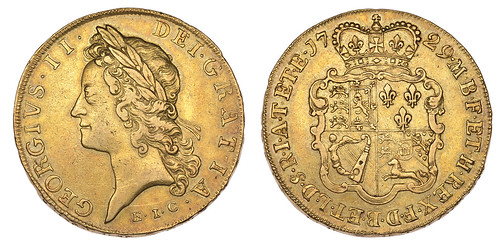
PREV ARTICLE
NEXT ARTICLE
FULL ISSUE
PREV FULL ISSUE
EAST INDIA COMPANY FIVE GUINEAS IN DNW SALEWill Bennett of Dix Noonan Webb forwarded this press release about a rare East
India Company coin in the London firm's December 2014 sale. Thanks. -Editor
 A rare Five Guineas coin minted from gold supplied to the Royal Mint by the East India Company in 1729 will be among the highlights of the auctions of Ancient, British and World Coins to be held by Dix Noonan Webb in London on 4–5 December 2014. The coin, which bears the head of George II, is expected to fetch £8,000 to £12,000. The source of the gold is shown by the letters ‘E.I.C.’ on the obverse of the coin underneath the king’s head. Guineas took their place in British numismatic history in 1662 when the recently restored Charles II decreed that the Mint would abandon hand-hammered coinage in favour of money produced in screw presses that could produce symmetrical coins with milled edges to deter clipping. Gold for this came to England in ships of the Africa Company from Guinea in West Africa and the new coins soon became known as guineas. The Africa Company’s badge of an elephant and howdah, more commonly called an elephant and castle, was depicted on the coins under the king’s bust. The practice of acknowledging the source of the gold continued into the 18th century with some guineas carrying the word LIMA to mark British successes in capturing Spanish treasure ships that had sailed from the city of Lima in Peru. The East India Company, which had originally received its Royal Charter from Elizabeth I in 1600, also became gold suppliers to the Royal Mint. Quite where the ruthless entrepreneurs who expanded the Company to become effective rulers of the Indian sub-continent, sourced their gold is unclear although it may have come from Japan. What is known from Treasury records is that on 4 November 1729 the Company wrote to the Lords of the Treasury requesting the preparation of dies with the capital letters ‘E.I.C’ under the King’s head to distinguish the coins minted from its gold “as hath been granted to the Royal African, the South Sea Company and others.” The East India Company got what it wanted. The coin to be auctioned at Dix Noonan Webb is rare. The letters ‘E.I.C.’ were only stamped on gold coins in 1729, two years after George II came to the throne, and five guineas are themselves rare because they represented an enormous amount of money. For more information, see:
Wayne Homren, Editor The Numismatic Bibliomania Society is a non-profit organization promoting numismatic literature. See our web site at coinbooks.org. To submit items for publication in The E-Sylum, write to the Editor at this address: whomren@gmail.com To subscribe go to: https://my.binhost.com/lists/listinfo/esylum All Rights Reserved. NBS Home Page Contact the NBS webmaster 
|